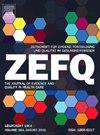[预防和预测儿童食物过敏的网络健康信息的内容和质量:系统评价]。
IF 1.7
Q4 HEALTH POLICY & SERVICES
Zeitschrift fur Evidenz Fortbildung und Qualitaet im Gesundheitswesen
Pub Date : 2025-01-21
DOI:10.1016/j.zefq.2024.11.010
引用次数: 0
摘要
导言:基于网络的健康信息如果质量高,即准确、可理解和无障碍,就可以支持与健康有关的决策。我们的研究系统地检索了关于预防和预测儿童食物过敏的德语、基于网络的健康信息,并评估了它们的内容和质量。方法:2022年7月,四名研究人员对基于德语的儿童食物过敏预测和预防健康信息(HI)进行了系统的谷歌搜索。它们使用预定义的搜索算法进行独立搜索。两名独立的审评者使用定性和定量内容分析(步骤/分析1)分析数据,并使用综合标准目录(透明度、文本设计、内容、语言、频率和统计信息的呈现、可视化和可及性)评估HI的质量(步骤/分析2)。结果:系统搜索得到59个网站,由9个部门提供。最常见的部门是“卫生门户网站和专家意见”和“指南/科学和医学专业信息”(各占22%)。内容分析(第1步)显示,除了其他事项外,预测主题只是隐式地处理。49份材料(83%)包含符合指南的信息。然而,也有26份(44%)材料的含量不符合现行的S3过敏预防指南。质量评估(步骤2)显示,43个HI中只有一小部分在透明度(n = 3.7%)和内容(n = 9.21%)标准方面获得了良好或非常好的评级。有关频率和统计信息的标准仅在11个HI(26%)中被评为良好或非常良好的质量。几乎所有HI都符合语言(n = 38, 88%)、文本设计(n = 43, 100%)和可视化(n = 43, 100%)的质量标准。就可及性标准而言,没有一个被评估的HI被给予良好或非常好的评级。按部门进行的分析显示,只有很小的差异(七项标准的平均值:56% - 69%)。结论:现有的基于网络的儿童食物过敏预防和预测健康信息的质量参差不齐。在可及性、内容(例如,有选择性地介绍预防措施)和透明度(例如,缺少联系方式的细节)方面需要改进。在预测和预防儿童食物过敏的背景下,扩大用户视角和分析社交媒体需要进一步的研究。本文章由计算机程序翻译,如有差异,请以英文原文为准。
Inhalt und Qualität webbasierter Gesundheitsinformationen zur Prävention und Prädiktion von Nahrungsmittelallergien bei Kindern: eine systematische Evaluation
Introduction
Web-based health information can support health-related decisions if it is of high quality, i. e. accurate, understandable and barrier-free. Our study systematically searched for German-language, web-based health information on the prevention and prediction of food allergies in children and assessed their content and quality.
Methods
In July 2022, four researchers conducted a systematic Google search for German-language web-based health information (HI) on the prediction and prevention of food allergies in children. They searched independently of each other with a predefined search algorithm. Two independent reviewers analyzed the data using qualitative and quantitative content analysis (step/analysis 1) and assessed the quality of HI (step/analysis 2) using a comprehensive criteria catalog (transparency, text design, content, language, presentation of frequencies and statistical information, visualization, and accessibility).
Results
The systematic search yielded 59 websites, which were provided by nine sectors. The most frequent sectors were “Health portals and expert opinions” and “Guidelines/scientific and medical specialized information” (22% each). The content analysis (step 1) showed, among other things, that the topic of prediction was only implicitly addressed. 49 materials (83%) contained guideline-compliant information. However, there were also 26 materials (44%) whose content was not in line with the current S3 guideline on allergy prevention. Quality assessment (step 2) revealed that only a small number of the 43 HI received good or very good ratings regarding the transparency (n = 3, 7%) and content (n = 9, 21%) criteria. The criterion concerning frequencies and statistical information was rated good or very good quality in only 11 HI (26%). Almost all HI met the quality criteria for language (n = 38, 88%), text design (n = 43, 100%), and visualization (n = 43, 100%). None of the evaluated HI was given a good or very good rating in terms of accessibility criteria. The analysis by sector revealed only minor differences (mean of the seven criteria: 56–69%).
Conclusion
The quality of the available web-based health information on the prevention and prediction of food allergies in children is highly heterogeneous. There is need for improvement in terms of accessibility, content (e. g., selective presentation of prevention measures), and transparency (e. g., missing details of contacts). Further research is needed for expanding the user perspective and analyzing social media in the context of prediction and prevention of food allergies in children.
求助全文
通过发布文献求助,成功后即可免费获取论文全文。
去求助
来源期刊

Zeitschrift fur Evidenz Fortbildung und Qualitaet im Gesundheitswesen
HEALTH POLICY & SERVICES-
CiteScore
1.90
自引率
18.20%
发文量
129
 求助内容:
求助内容: 应助结果提醒方式:
应助结果提醒方式:


